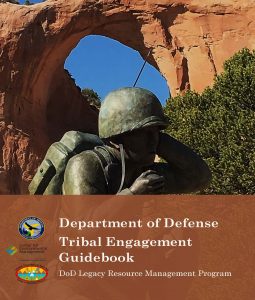
The U.S. Department of Defense has released a new guidebook aimed at helping its personnel build and maintain collaborative relationships with federally recognized sovereign tribal nations, particularly concerning land and environmental issues.
The Department of Defense Tribal Engagement Guidebook helps promote consistent language in communications, effective management strategies of tribal resources on DOD-managed lands and compassionate and respectful approaches in government-to-government relationships.
The guidebook was funded by the department’s Legacy Resource Management Program, which is charged with protecting environmental and cultural resources managed by military installations. It was written by lead author Michael Fedoroff from the Alabama Water Institute and co-authored by Arianne Kitchens, an outreach specialist with the U.S. Army Corps of Engineers Tribal Nations Technical Center of Expertise, or USACE TNTCX.
“This project had its start in a presidential memo for federal agencies to begin incorporating traditional ecological knowledge into U.S. science-based decision making,” said Fedoroff, AWI’s director of cultural and water resources preservation. “Different service branches had their own guidance, but the DOD wanted a consistent framework for everyone working together with tribal communities.”
Fedoroff, a U.S. Army veteran and former deputy director and research lead for the USACE TNTCX, and Kitchens were charged with creating the guidebook. It aids personnel such as installation commanders, cultural resource professionals, tribal liaisons and others who may work on matters of concern to tribal nations.
“Federally recognized tribes hold a higher legal status than the general public,” said Fedoroff. “They self-determine their own way of doing business within their tribally owned lands, determine their own tribal citizenship and any of the revenues they generate through tribal enterprises go back into their own economy.”
The guidebook provides insights into setting up consultation meetings, co-developing agendas and proper etiquette when speaking with tribal elders. It breaks down the basics of cross-cultural communications and the proper way to discuss sensitive topics such as sacred sites on military installations and the history between the federal and sovereign tribal governments.
“It explains the difference between collaboration, consultation and coordination, which are three very different forms of communication between our governments,” Fedoroff said. “If you’ve never worked with a tribal community before, this helps you learn about laws and rules between the two and how to make it easier to overcome those barriers.”
Tribal nations have a deep understanding of traditional land management and how ecosystems work, so issues such as water rights, quality and infrastructure are significant to them. Fedoroff used that insight as a key basis of his work on the guidebook and how he approaches his role at AWI.
“Tribes traditionally think seven generations ahead on their science decision making, which is called the ‘Seventh Generation Principle,’” he said. “That is something that we here at AWI certainly try to stand by in our environmental watershed protection and science-based projects that we do.”
As the guidebooks continues to evolve, Fedoroff wants to see more in-depth on guidance and best practices for dealing with tribal nations in Alaska and Hawaii.
“More than half of our federally recognized tribes are in Alaska, so we definitely need to get out there and make sure that we’re supporting their needs and good communication to those groups as well,” he said.
